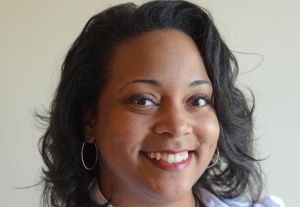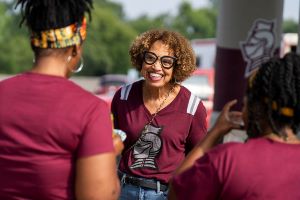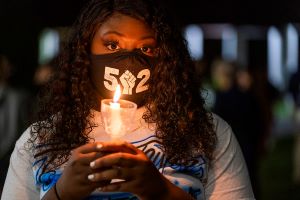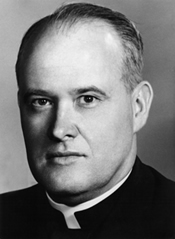As Black History Month draws to a close, we take a big-picture look at Bellarmine’s diversity efforts.
Over the past eight years, the percentage of students of color at Bellarmine University has steadily grown, with this year’s first-year class setting a record: 33% percent of 634 students, a 6% gain year-over-year and the largest number in Bellarmine's
history. The percentage of employees of color has also increased, from 8% in 2016 to the current 12%.
These increases are the result of the Bellarmine community’s deliberate steps to increase diversity on campus and, equally as important, to ensure that students, faculty and staff members of color feel welcome, included and supported.
They also reflect a commitment to diversity that has existed at Bellarmine since the day the college opened its doors.
Three black students were among the 112 who entered the brand-new Bellarmine College in 1950. That was also the year that a state law prohibiting blacks and whites from being educated together in public or private school at any level was amended to allow—but
not require—black students to attend colleges that offered courses not available at the all-black Kentucky State College for Negroes in Frankfort.
At the time, Louisville was still a fully segregated city, with segregated public transportation, theaters, restaurants, stores, swimming pools, public parks and water fountains.
Fr. Alfred F. Horrigan, Bellarmine’s founding president, and the presidents of Nazareth (now Spalding) and Ursuline colleges announced in The Courier-Journal that black students would be accepted in all their classes, writing, “When the right
to intellectual and spiritual development which is the proper concern of higher education is curtailed by the physical accident of race, there is implicit in such curtailment a materialistic philosophy of life which is intolerable in a Christian and
democratic society.”
In May 2019, Bellarmine’s leadership reaffirmed the importance of diversity at Bellarmine by designating Equity and Inclusion as one of the six major pillars of the university’s new strategic plan, Tradition and Transformation.
“To develop meaningful inclusion and engagement, we must expand our principles of hospitality to cultivate a true sense of belonging, beyond just being present, so that everyone sees that Bellarmine is a place for them,” the strategic plan
reads. “Reaffirming Thomas Merton’s values of inclusion and compassion, we must foster critical dialogues, informed collaborative engagement and transformative teaching.”
That same year, President Susan M. Donovan created the
President’s Advisory Board on Equity and Inclusion. It was co-chaired by Dr. Donald “DJ” Mitchell Jr., Bellarmine’s inaugural Chief Diversity, Equity and Inclusion Officer
(CDEIO), an appointment that Donovan called “a milestone in our progress to demonstrate a fully realized and lived commitment to inclusion.”
The CDEIO advises the president and other Cabinet members on university-wide initiatives, programs and policies. One early initiative was the Bellarmine Black Caucus, an affinity group created to support the growing number of black faculty and staff.
e0732e97fcf16c298b1dff00007f963e.jpg?sfvrsn=db824280_4) “The goal of the caucus is really to foster a campus climate and culture of unity, equity and respect,” says Dr. Leslie Maxie, Bellarmine’s Dean of Students, who has been at the university for more than two decades and was a founding
co-chair of the group, which was renamed the Bellarmine Black Faculty & Staff Alliance in Fall 2023.
“The goal of the caucus is really to foster a campus climate and culture of unity, equity and respect,” says Dr. Leslie Maxie, Bellarmine’s Dean of Students, who has been at the university for more than two decades and was a founding
co-chair of the group, which was renamed the Bellarmine Black Faculty & Staff Alliance in Fall 2023.
"I have seen us work for more than 20 years to be a more diverse and inclusive campus in thought and demographics. This fall we welcomed our most diverse class of students to Bellarmine. This did not happen overnight. This happened because of the dedication of our faculty, staff and administration to live out our mission," Dr. Maxie said. "I could not be prouder of who we are today but also recognize that there is still much work to do. I am confident that we will continue to be intentional about fostering a sense of belonging and hold steadfast to our commitment to diversity, equity and inclusion for our students, faculty and staff."

Bellarmine’s current CDEIO, Dr. Tomarra Adams, succeeded Mitchell in July 2022.
Adams said that Bellarmine’s mission, vision and commitment to equity and inclusion drew her to the university. “Knowing there is a strong cadre of colleagues and students who have been championing this work and are eager to continue to reflect,
listen, learn and grow as a community bolsters my enthusiasm to join Bellarmine,” she said.
“It is clear that the leadership has renewed vision and synergy in expanding accessible pathways to a college degree for those who have been historically marginalized, having a faculty and staff representative of a shifting demographic of students,
and creating opportunities for meaningful institutional change, partnerships, and teaching that embrace an inclusive environment both within and outside of the classroom.”
As the number of underrepresented students grew, Bellarmine responded in the summer of 2016 with a new pre-orientation retention initiative called Early Knights, now known as
Knights of Color. The free yearlong program, primarily for incoming first-year
and transfer students of color, includes the option to move onto campus early to ease the transition from high school to college and continues throughout the academic year with study halls, tutoring, skills workshops, one-on-one meetings with mentors,
and additional social and educational programming.
In the fall of 2016, the Office of Multicultural Affairs became the Office of Identity and Inclusion (OII) and moved from a single room into the larger space formerly occupied by Campus Ministries. Since then, the OII has created #BUDialogues, a monthly,
hourlong discussion focusing on identity and/or social justice that is open to students, faculty and staff; begun a program to train Diversity Peer Educators, student leaders who serve as OII ambassadors and help create brave spaces across campus;
and co-hosted Dialogue on Diversity, an annual daylong conference open to students and professionals dedicated to engaging in constructive dialogue about identity and diversity in the workplace.

At the dedication, Dr. Carver reflected on her experiences over her 18 years at Bellarmine. Immediately upon arriving at Bellarmine in 2002, she became an advisor for the
Black Student Union, an organization that had become an important influence for
diversity on campus in the mid-1960s, when books and magazines on black history and culture were added to the library and courses in black studies were added to the curriculum.
In the early 2000s, Dr. Carver recalled, “no ‘official’ space existed for students [of color] to meet regularly on campus. A dedicated space where students could gather, find solace and simply be themselves was nonexistent. Many faculty
and staff opened their homes for students to have a safe space to just be themselves.”
It was during the renovation of Horrigan Hall during the construction of Centro that Dr. Carver saw the opportunity to give back to Bellarmine, where she earned her Ph.D., by helping to finance the expansion of the OII. The renaming of the center was
an unexpected honor, she said. “My focus has always been—and will continue to be—on the well-being and empowerment of our students.”
The summer of 2020 saw the Bellarmine community joining the worldwide movement to demand racial justice following the deaths of four black people in the United States, including Breonna Taylor in Louisville.
Faculty, staff and students attended protests and organized campus events, such as a Faculty and Staff Community Conversation and a Prayer Vigil for Racial Unity and Justice. Students also worked with the offices of Identity and Inclusion and Public Safety
to collect more than $4,000 and two vanloads of supplies like water and snacks for Louisville’s protesters.

Kelze' Riley, who was then a senior majoring in Political Science and Criminal Justice and is now in law school at the University of Cincinnati, helped to organize the student protest held in observance of what would have been Breonna Taylor’s 27th
birthday. She said at the time that it meant a lot to her that campus administration was willing to support the effort and that students showed up to march in solidarity.
“I know Bellarmine is a lasting home for me because the people in this community supported us,” Kelze’ said.
Dr. Helen-Grace Ryan, Bellarmine's vice president of Student Affairs, said students’ involvement and leadership in 2020 were remarkable. “I’m infinitely proud of our students,” she said. “They’re finding their voice
and standing up for the rights of others, and that is a critical part of the college experience.”
It is also an integral part of the Bellarmine experience.
In 1964, Dr. Martin Luther King Jr. led a civil-rights march on the Kentucky state capital, and Bellarmine faculty and students marched with him.
Also that year, 35 Bellarmine faculty members signed a letter to Kentucky’s congressional delegation urging members to support the federal Civil Rights Bill. And three Bellarmine students were with a Bellarmine philosophy professor in Mississippi
renovating community centers for black people and encouraging them to vote.
In 1965, Louisville Mayor Bill Cowger appointed Fr. Horrigan chair of the Louisville Commission on Human Rights, and Fr. John Loftus, academic dean, joined about 50 other Louisvillians for the final two days of the civil rights march from Selma to Montgomery,
Alabama. The Rev. C.T. Vivian, one of the organizers of that march, spoke on Bellarmine’s campus.
In 1966, the Kentucky Civil Rights Act was finally passed—a full 16 years after three black students had entered the new Bellarmine College.

Almost 30 years later, Fr. Horrigan reflected on his and Fr. Loftus’ sometimes controversial civil-rights activities.
“I’m sure some students and others were opposed to our work. I know we were somewhat ahead of most people. One consequence of our activities was that we never had a campus-wide crisis, as happened on so many other campuses during the unrest
of the ’60s. It was as though our work defused student criticism,” he said in High Upon a Hill, a history of Bellarmine written by Wade Hall. “Of course, most of the opposition to my activities came from the adult community. In the
mid-’60s, three or four members of our Board of Overseers resigned in protest of my work.
“I always thought, however, that I was doing one of the missions of the college in trying to promote human rights and social justice. I thought Bellarmine should not only be a place of education for our students, but an example to the entire community.”